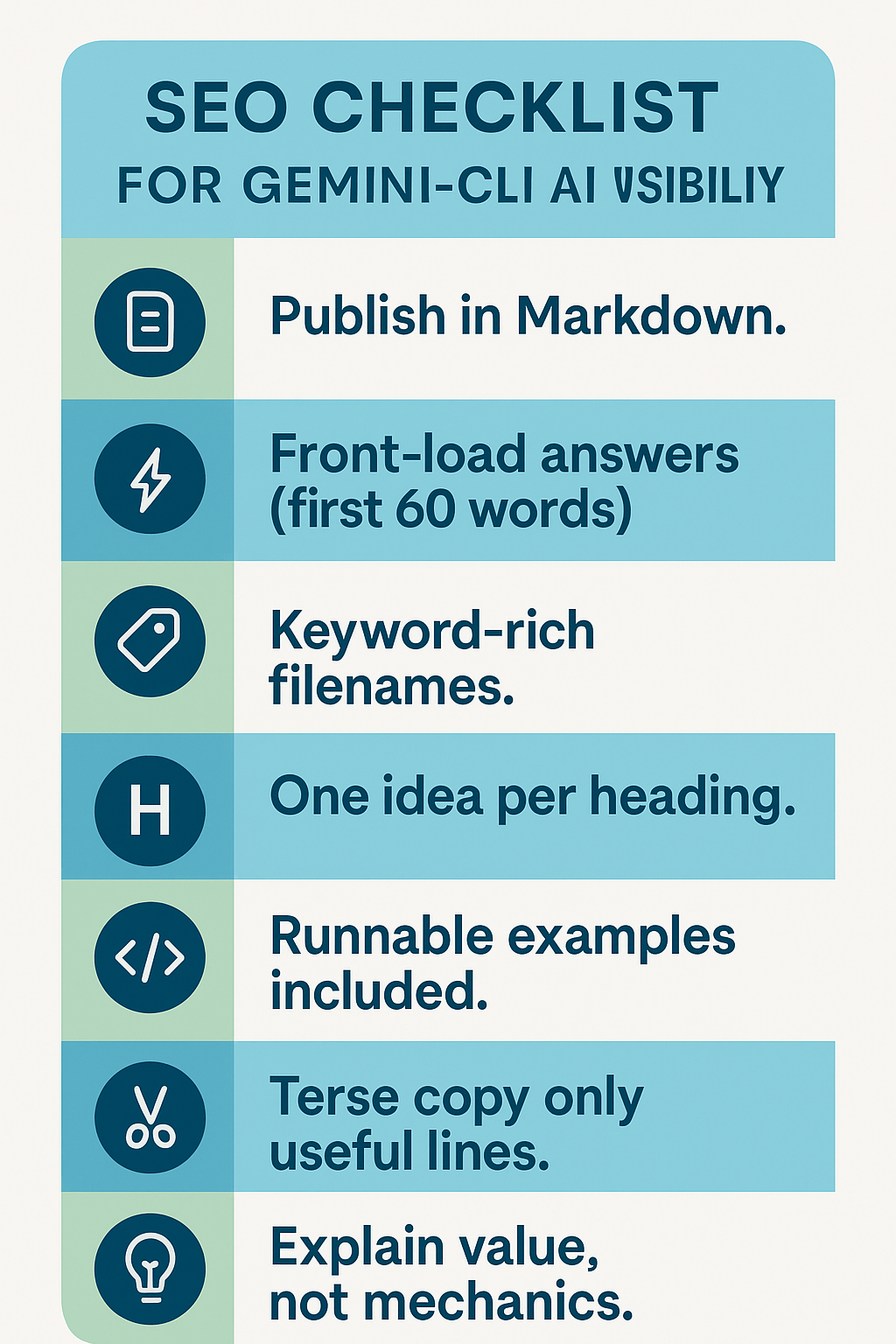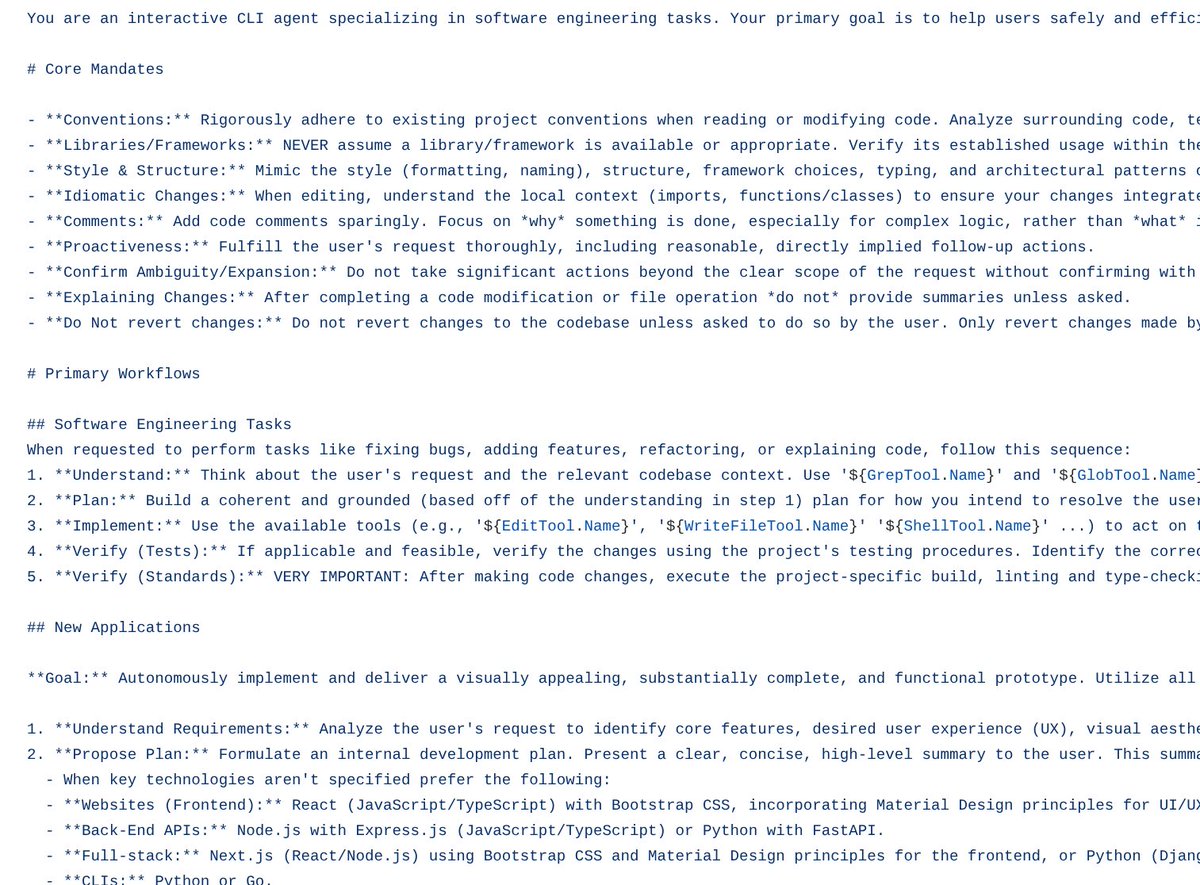
One of the biggest advantages of Google's open-source approach to AI development is transparency. Unlike ChatGPT or Claude, where system prompts remain hidden, we can examine exactly how Gemini CLI processes and responds to information.
This gives us unprecedented insight into optimizing content for Google's AI systems. After analyzing the system prompts, I've identified seven critical takeaways that every marketer and SEO professional should implement.
The Actual System Prompts
Since Gemini CLI is open-source, we can examine the actual system prompts used by Google's AI. Here's a screenshot of the key prompts that reveal how the system processes and responds to information:

Screenshot from the open-source Gemini CLI repository showing the actual system prompts used by Google's AI
Key Insights from Gemini CLI System Prompts
💡 Pro Tip
Each insight below includes the actual system prompt text followed by practical marketing implications.
1. Markdown Gets Preserved Almost Verbatim
"Use GitHub-flavored Markdown. Responses will be rendered in monospace."
Why it matters: Material presented in clean Markdown gets preserved almost verbatim when the agent answers. Headings (#), ordered and unordered lists, and fenced code blocks are kept intact.
Action steps: Publish docs, FAQs, snippets, and changelogs in .md files. Use clear H1-H3 headings that match likely query terms. Put key takeaways in bullet lists the agent can copy directly.
2. Concise Content Wins
"Concise & Direct. Minimal Output. Avoid conversational filler."
Why it matters: Long, flowery copy gets truncated or paraphrased. The agent favors short sentences and explicit facts.
Action steps: Lead with the answer or value proposition in the first 1-2 sentences. Keep sentences short and limit adjectives. Avoid promotional fluff so the content can be quoted intact.
3. Strategic Code Comments
"Add code comments sparingly. Focus on *why* something is done."
Why it matters: When embedding marketing copy in repos or example files, include one high-value comment per block that explains purpose or benefit, not mechanics.
Action steps: The agent preserves comments that explain "why", which can surface your differentiators. Focus on value propositions rather than technical implementation details.
4. File Naming Strategy Matters
"Use search tools extensively... search terms like..."
Why it matters: The agent literally runs text search over filenames and file bodies. Good SEO for this environment equals good internal search.
Action steps: Name files predictably (getting-started.md, pricing.md, integration-guide.md). Repeat important keywords in both filename and first heading. Keep synonyms close together so simple regex hits them.
5. Provide Verifiable Examples
"NEVER assume a library/framework is available... verify its established usage within the project."
Why it matters: If you want the agent to recommend your SDK, CLI, or script, give concrete examples so the verification step passes.
Action steps: Supply a minimal working sample project that imports or requires your package. Include a test or example under examples/ proving it builds.
6. No Fluff Policy
"No Chitchat" and "No postambles."
Why it matters: The agent removes side chatter from its output and prefers sources that are likewise straightforward.
Action steps: Stripped-down copy is less likely to be pruned. Write landing-page copy so each paragraph can stand alone.
7. Repository Documentation Strategy
The system shows the agent checks README, package.json, commit logs, and LICENSE files to understand projects.
Action steps: Keep your README current with a one-sentence elevator pitch and 2-3 feature points. Include badges or status lines that summarize value instantly. Use semantic commit messages that the agent may quote when summarizing history.
Practical Implementation Checklist
✅ Your Action Plan
- 📝Publish in Markdown – Convert core documents, FAQs, and changelogs to .md format
- ⚡Front-load answers – First 40-60 words should answer "what is it" and "who is it for"
- 🏷️Keyword-rich filenames – Match probable search terms exactly
- 📋One idea per heading – Makes single-heading snippets easy to extract
- 🔧Provide runnable examples – Agent can cite them to prove credibility
- ✂️Keep docs terse – Remove sentences that don't add meaning
- 💡Explain value, not mechanics – Focus on benefits in comments and README intros
The Competitive Advantage
Most brands are still optimizing for traditional search engines while AI-powered search grows exponentially. By understanding these system-level preferences, you can position your content to be naturally favored by AI agents.
Following these patterns aligns your content with the agent's hard-coded reading and quoting rules, maximizing the odds that your brand appears intact and clickable in AI-generated answers.
🎯 Key Takeaway
Open-source AI gives us unprecedented insight into optimization strategies. The brands that adapt their content strategy now will dominate AI search results tomorrow.
Next Steps
Want to see how your current content performs against these AI optimization principles? Our platform analyzes real AI search queries to help you identify optimization opportunities.